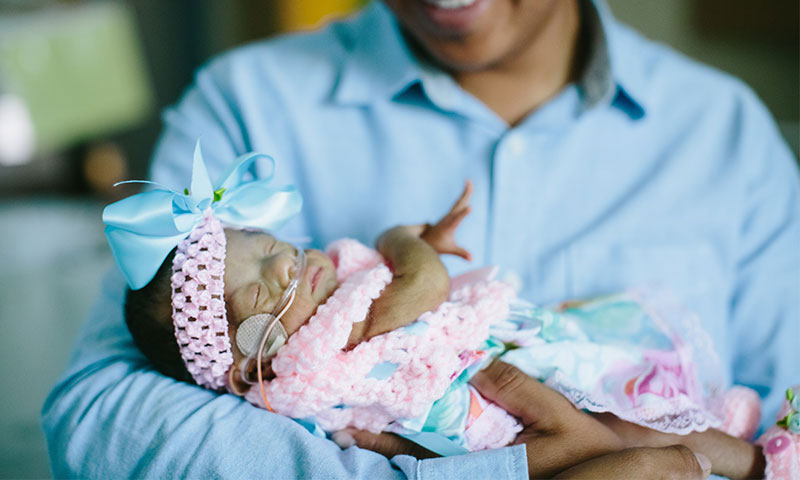Baby Andrea was born 3 months before her due date and until her delivery by emergency cesarean section, her mother, Brenda, had had a relatively uneventful pregnancy. As soon as Andrea was born it was discovered that she had a giant sacrococcygeal teratoma at the base of her tailbone. A sacrococcygeal teratoma is a tumor that develops in-utero and arises from the base of the tailbone. It is the most common tumor seen in newborn babies. Most teratomas are not cancerous, but these giant tumors can cause severe circulatory problems before and after birth. Being premature, Andrea was only a little over a foot in length, and the tumor was as big as she was, making it potentially life-threatening.
Physicians, including Luc Brion, M.D., a neonatologist at Children’s Health℠ and Professor of Pediatrics at UT Southwestern and the specialized resuscitation team at the Parkland Labor and Delivery Unit, provided lifesaving resuscitation for Andrea immediately after delivery. Given her size and the size of her tumor, they knew it was a critical situation and the Newborn Resuscitation team was there to help. This team, directed by Myra Wyckoff, M.D., a pediatric physician at Children’s Health and Associate Professor of Pediatrics at The University of Texas Southwestern Medical Center, is world renowned and provides key input to set international standards and protocols for neonatal resuscitation. Their expertise helped to give Andrea a fighting chance at life.
Once Andrea was stabilized, she was transferred to the Neonatal Intensive Care Unit (NICU) at Children’s Medical Center Dallas, the only NICU in North Texas to be designated as a Level IV (the highest level of neonatal care) by the Texas Department of State Health Services and nationally ranked by U.S. News & World Report on its “Best Children’s Hospitals” list. “Within the first two days of her life, Andrea had to be started on medications to help her lungs and maintain her blood pressure while requiring transfusions for poor clotting.” says Vedanta Dariya, M.D., Associate Medical Director, Children’s Medical Center NICU, Assistant Professor, Pediatrics, UT Southwestern Medical Center, and the physician in charge of her care for her first two months of life. “In addition to all the medical issues that a premature infant faces, the tumor was worsening her lung and heart condition, and there was bleeding into the tumor itself.”
The optimal approach to these tumors is to surgically remove them. However, Andrea’s condition was critical and the operation carried high risks. After many discussions with the medical and surgical teams, when Andrea was just three days old, her parents had to make a choice they never imagined they would have to make: Either move forward with surgery, knowing the extreme risks given Andrea’s condition, or cease any medical interventions, realizing that Andrea would very likely not survive much longer.
“Her father and I just knew we had to give her one last fighting chance, so we gave the team the go-ahead to perform surgery to remove the tumor,” Brenda says, choking back tears.
The surgery was long, taking more than 4 hours, with two surgeons and operating room staff, two anesthesiologists and the bedside medical team of doctors, nurses, nurse practitioners and respiratory therapists working together. The surgery was a complete success. Dr. Dariya credits the incredible coordinated expertise of the entire surgical and medical teams for the positive outcome. “To put into perspective how serious her condition was, during surgery the team essentially replaced her entire blood supply almost three times over the course of the procedure,” he says. Still, Andrea had a challenging road ahead of her as she recovered from surgery and faced other issues related to her premature birth. She was severely jaundiced and had breathing and feeding challenges to overcome. However, after nearly 70 days in the NICU, she was finally discharged home - even before her expected due date.
Brenda says that throughout it all, she felt confident that her daughter was in good hands. “The nurses treated Andrea like she was their baby as well,” she says. “They cared for her so well and I felt 100% comfortable with any nurse or doctor taking care of her during her hospital stay.”
Andrea still has regular check-ups with the Pauline Allen Gill Center for Cancer and Blood Disorders at Children’s Health to monitor blood levels to make sure that the tumor does not recur. Additionally, she is followed in the Thrive program, which provides specialized, ongoing follow-up care to former NICU patients. The Thrive program is focused on supporting each infant’s overall health until their fifth birthday, including routine well-child visits and immunizations as well as assessing any cognitive, behavioral or emotional needs that may require additional attention.
For Brenda, continuing her child’s care at Children’s Medical Center in Dallas was the obvious choice. “They know her story and have been involved in her care from the beginning,” she says. “I didn’t feel like I could trust any doctor with her care unless it was one from Children’s and UT Southwestern.”

Thank you!
You are now subscribed to the Children's Health Family Newsletter.
Children's Health will not sell, share or rent your information to third parties. Please read our privacy policy.
